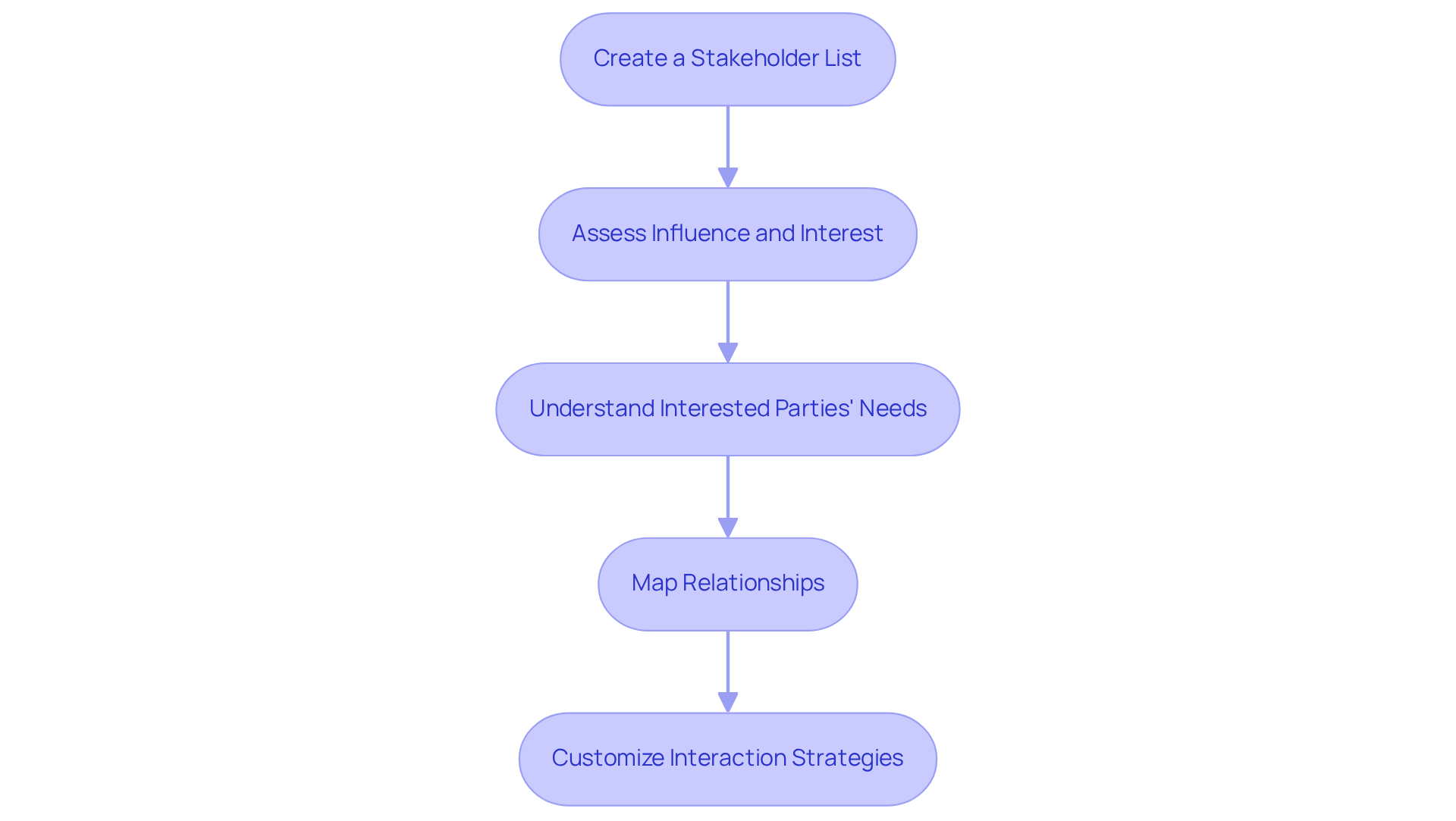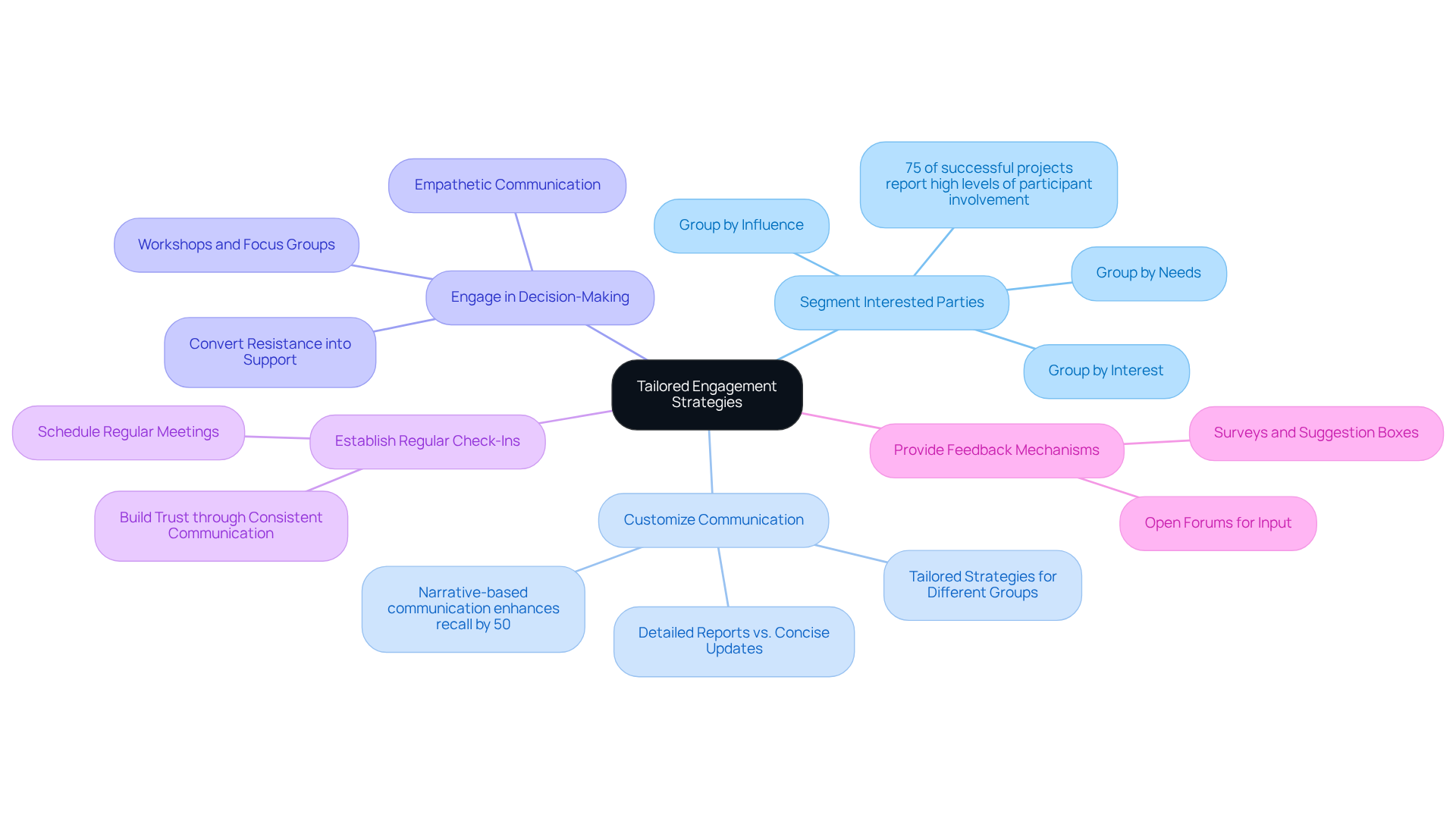Overview
This article delves into the internal stakeholder management framework, underscoring its critical role in identifying, engaging, and managing individuals within an organization who significantly influence its success. It articulates essential components such as stakeholder identification, engagement strategies, and the imperative of continuous monitoring and adjustment. Organizations that prioritize these relationships are poised to achieve superior performance and enhanced employee satisfaction.
Moreover, understanding the dynamics of stakeholder management not only fosters better communication but also cultivates a more collaborative environment. By implementing effective engagement strategies, organizations can build trust and loyalty among their stakeholders, leading to sustainable success.
In conclusion, it is vital for organizations to recognize the importance of internal stakeholder management. By actively engaging and managing these relationships, businesses can drive performance and satisfaction to new heights. Take action now to assess and enhance your stakeholder management practices for long-term success.
Introduction
Understanding the intricate web of relationships within an organization is essential for driving success. The internal stakeholder management framework serves as a strategic guide for identifying and engaging those individuals and groups whose interests and influence are pivotal to an organization's achievements. As businesses strive to enhance collaboration and performance, the challenge lies in effectively managing these internal dynamics.
How can organizations ensure that they not only recognize the voices of their stakeholders but also engage them in a way that aligns with overarching goals? This article delves into the critical components of internal stakeholder management, offering insights and strategies to master this vital framework.
Define Internal Stakeholder Management
The strategic process of identifying, engaging, and managing individuals or groups within a structure who have a vested interest in its operations and outcomes is known as the internal stakeholder management framework. This includes staff, supervisors, and leaders whose impact or interests are vital to the entity's achievement. Efficient handling of these parties is crucial for promoting teamwork, improving communication, and aligning their interests with the broader objectives of the entity. By comprehensively understanding the dynamics of internal relationships, businesses can significantly improve decision-making processes, boost employee morale, and drive overall performance.
Key components of internal stakeholder management include:
- Identification: Recognizing the internal stakeholders who play a role in the organization’s success.
- Engagement: Actively involving participants in decision-making processes to ensure their perspectives are considered. Our team supports a shortened decision-making cycle throughout the turnaround process, allowing your team to take decisive action to preserve your business.
- Communication: Sustaining clear and regular information exchange to keep interested parties informed and engaged.
- Feedback: Collecting input from interested parties to enhance strategies and initiatives, ensuring alignment with their needs and expectations. We continually monitor the success of our plans and teams through our client dashboard, which provides real-time business analytics to continually diagnose your business health.
The significance of the internal stakeholder management framework cannot be overstated; organizations that prioritize these relationships often experience enhanced performance and greater employee satisfaction. For example, a study by the Project Management Institute showed that projects with actively involved participants are up to 70% more likely to achieve their initial objectives. Moreover, companies with robust connections to their interested parties experience a 20% higher total shareholder return compared to those with weak relationships, as noted by McKinsey & Company. Furthermore, Unilever's Sustainable Living Plan demonstrates the effectiveness of engaging with interested parties in driving business growth, as brands aligned with this plan are expanding at double the speed of the rest of the business. These examples highlight the essential role of the internal stakeholder management framework in achieving sustainable success.

Identify and Analyze Internal Stakeholders
To effectively manage internal parties, it is essential to start with a clear internal stakeholder management framework. This can be accomplished through the following steps:
-
Create a Stakeholder List: Compile a detailed list of all individuals and groups within the company, including employees, management, and board members.
-
Assess Influence and Interest: Evaluate the level of influence and interest of each party in the organization's operations. Using a participant matrix can assist in classifying them into high, medium, and low influence and interest, offering a clear visual depiction of their roles.
-
Understand Interested Parties' Needs: Conduct interviews or surveys to gather insights into their expectations and concerns. Interacting with interested parties directly can result in a 20% rise in participation rates, emphasizing the importance of seeking active feedback.
-
Map Relationships: Visualize the connections between parties to understand their interactions and influence dynamics. This mapping can uncover possible allies and opponents, facilitating more strategic interaction methods.
By thoroughly recognizing and examining internal parties within an internal stakeholder management framework, organizations can customize their interaction strategies effectively, ensuring alignment with the needs of those involved and enhancing overall project success. This structured approach not only fosters collaboration but also increases the likelihood of achieving organizational goals, as companies that engage effectively are 50% more likely to reach their objectives.

Develop Tailored Engagement Strategies
Once internal participants have been recognized and assessed, the next step is to create customized interaction strategies. Here are some effective approaches:
- Segment Interested Parties: Group individuals based on their influence, interest, and needs. This allows for more focused engagement efforts, ensuring that communication is relevant and impactful. According to Deloitte, 75% of successful projects report high levels of participant involvement and buy-in from the start, highlighting the importance of this step.
- Customize Communication: Develop communication strategies tailored to the preferences of various interest groups. For instance, while some parties may prefer detailed reports, others might favor concise updates. Customizing communication enhances involvement and ensures that messages resonate with each group. Research indicates that narrative-based communication can enhance participant recall and engagement by as much as 50%, showcasing the effectiveness of this method.
- Engage Interested Parties in Decision-Making: Create opportunities for involved individuals to participate in discussions and decisions that affect them. This can include workshops, focus groups, or advisory committees, fostering a sense of ownership and commitment to organizational goals. Addressing potential resistance through empathetic communication can convert opposition into support, further enhancing participant involvement.
- Establish Regular Check-Ins: Schedule regular meetings or updates to keep interested parties informed and engaged. Consistent communication builds trust and ensures that their concerns are addressed promptly, reinforcing their value within the organization.
- Provide Feedback Mechanisms: Establish channels for participants to provide input on initiatives and decisions. This can include surveys, suggestion boxes, or open forums, allowing participants to express their views and feel acknowledged.
By creating customized interaction strategies, entities can cultivate stronger connections with their internal participants, which will enhance their internal stakeholder management framework and result in improved collaboration and backing for institutional initiatives. Efficient collaboration with interested parties not only enhances project results but also fosters an atmosphere of trust and mutual respect, which is vital for long-term success.

Monitor and Adjust the Stakeholder Management Plan
To ensure the effectiveness of a participant management plan, organizations must continuously monitor and adjust their strategies. Here are key steps to follow:
- Set Clear Objectives: Define what success looks like for participant involvement and establish measurable goals. This clarity aids in aligning efforts with the expectations of involved parties.
- Collect Feedback Consistently: Utilize surveys, interviews, and informal check-ins to gather input from participants regarding their experiences and satisfaction with involvement efforts. Consistent feedback is essential; organizations that pay attention to their contributors perform 15% better in their strategies.
- Examine Participation Data: Review participation metrics, such as Net Promoter Scores (NPS) and client retention rates, to identify trends, successes, and areas for enhancement. For example, entities that incorporate input from interested parties into product development experience a 30% higher adoption rate. Moreover, utilizing real-time business analytics via a client dashboard can improve this analysis, enabling organizations to consistently assess their partner interaction health.
- Modify Approaches as Required: Based on the analysis, implement essential changes to involvement strategies to more effectively align with the needs and expectations of interested parties. A streamlined decision-making cycle can facilitate these adjustments, enabling teams to take decisive actions swiftly. Involved parties can enhance project success rates considerably, with studies indicating that 78% of projects thrive with active participation from those involved.
- Convey Modifications: Keep interested parties updated on any alterations to the involvement strategy and clarify the reasoning behind these modifications. Openness in communication nurtures trust and improves participant satisfaction, as shown by the 85% of individuals who believed engagement greatly impacted their view of organizational transparency. A notable example is Microsoft, whose feedback implementation program achieved an 87% success rate by creating dedicated teams that address suggestions promptly.
By actively monitoring and adjusting the internal stakeholder management framework, organizations can remain responsive to the evolving needs of their internal stakeholders, ultimately leading to more effective collaboration and improved project outcomes.

Conclusion
Mastering the internal stakeholder management framework is essential for organizations aiming to enhance collaboration and achieve their strategic objectives. By effectively identifying, engaging, and managing internal stakeholders, businesses can align their interests with overarching goals, fostering a culture of teamwork and communication that drives success.
The article outlines several key components of internal stakeholder management, including:
- The importance of identifying stakeholders
- Engaging them in the decision-making process
- Maintaining clear communication
Organizations that prioritize these relationships not only experience improved performance but also enjoy higher employee satisfaction and better project outcomes. Evidence presented, such as studies highlighting the correlation between stakeholder engagement and project success, underscores the critical nature of these relationships in achieving sustainable growth.
In a rapidly evolving business landscape, the ability to adapt and respond to the needs of internal stakeholders is paramount. Organizations are encouraged to:
- Implement tailored engagement strategies
- Continuously monitor their stakeholder management plans
- Adjust their approaches as necessary
By doing so, they can cultivate stronger connections with their internal participants, ultimately leading to enhanced collaboration and a more robust organizational framework. Embracing these practices not only positions businesses for immediate success but also sets the foundation for long-term resilience and achievement.
Frequently Asked Questions
What is internal stakeholder management?
Internal stakeholder management is the strategic process of identifying, engaging, and managing individuals or groups within an organization who have a vested interest in its operations and outcomes. This includes staff, supervisors, and leaders whose impact or interests are vital to the organization's success.
Why is internal stakeholder management important?
Efficient handling of internal stakeholders is crucial for promoting teamwork, improving communication, and aligning their interests with the broader objectives of the organization. It can significantly enhance decision-making processes, boost employee morale, and drive overall performance.
What are the key components of internal stakeholder management?
The key components include: - Identification: Recognizing the internal stakeholders who contribute to the organization's success. - Engagement: Actively involving stakeholders in decision-making processes. - Communication: Maintaining clear and regular information exchange. - Feedback: Collecting input from stakeholders to enhance strategies and ensure alignment with their needs.
How does engagement with internal stakeholders affect project success?
A study by the Project Management Institute found that projects with actively involved participants are up to 70% more likely to achieve their initial objectives.
What is the impact of strong internal stakeholder relationships on shareholder returns?
Companies with robust connections to their internal stakeholders experience a 20% higher total shareholder return compared to those with weak relationships, according to McKinsey & Company.
Can you provide an example of effective internal stakeholder management?
Unilever's Sustainable Living Plan illustrates effective engagement with stakeholders, as brands aligned with this plan are growing at double the speed of the rest of the business, demonstrating the impact of stakeholder management on business growth.




